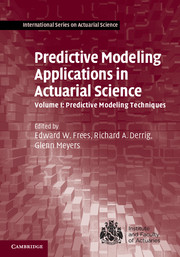Book contents
- Frontmatter
- Contents
- Contributor List
- Acknowledgments
- 1 Predictive Modeling in Actuarial Science
- II Predictive Modeling Foundations
- II Predictive Modeling Methods
- III Bayesian and Mixed Modeling
- 13 Bayesian Computational Methods
- 14 Bayesian Regression Models
- 15 Generalized Additive Models and Nonparametric Regression
- 16 Nonlinear Mixed Models
- IV Longitudinal Modeling
- Index
- References
14 - Bayesian Regression Models
from III - Bayesian and Mixed Modeling
Published online by Cambridge University Press: 05 August 2014
- Frontmatter
- Contents
- Contributor List
- Acknowledgments
- 1 Predictive Modeling in Actuarial Science
- II Predictive Modeling Foundations
- II Predictive Modeling Methods
- III Bayesian and Mixed Modeling
- 13 Bayesian Computational Methods
- 14 Bayesian Regression Models
- 15 Generalized Additive Models and Nonparametric Regression
- 16 Nonlinear Mixed Models
- IV Longitudinal Modeling
- Index
- References
Summary
Chapter Preview. In this chapter we approach many of the topics of the previous chapters, but from a Bayesian viewpoint. Initially we cover the foundations of Bayesian inference. We then describe the Bayesian linear and generalized regression models. We concentrate on the regression models with zero-one and count response and illustrate the models with real datasets. We also cover hierarchical prior specifications in the context of mixed models. We finish with a description of a semi-parametric linear regression model with a nonparametric specification of the error term. We also illustrate its advantage with respect to the fully parametric setting using a real dataset.
Introduction
The use of Bayesian concepts and techniques in actuarial science dates back to Whitney (1918) who laid the foundations for what is now called empirical Bayes credibility. He noted that the solution of the problem “depends upon the use of inverse probabilities.” This is the term used by T. Bayes in his original paper (e.g., Bellhouse 2004). However, Ove Lundberg was apparently the first one to realize the importance of Bayesian procedures (Lundberg 1940). In addition, Bailey (1950) put forth a clear and strong argument in favor of using Bayesian methods in actuarial science. To date, the Bayesian methodology has been used in various areas within actuarial science; see, for example, Klugman (1992), Makov (2001), Makov, Smith, and Liu (1996), and Scollnik (2001).
- Type
- Chapter
- Information
- Predictive Modeling Applications in Actuarial Science , pp. 334 - 366Publisher: Cambridge University PressPrint publication year: 2014

